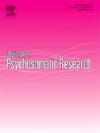Multidimensional outcomes associated with chronic fatigue over 12 months in youth with emerging mood disorders
IF 3.5
2区 医学
Q2 PSYCHIATRY
引用次数: 0
Abstract
Background
Complaints of chronic fatigue lasting weeks or longer are common during adolescence. Little is known about factors associated with chronic fatigue in youth with mood disorders or potential sex-specific associations.
Methods
496 young people (mean age = 18.36-years, SD = 3.22; 69 % female) seeking help for mental healthcare were assessed on psychological symptoms, lifestyle, and sleep at baseline and 12-months later. Fatigue was defined as a score of ≥3 on the somatic subscale of the Somatic and Psychological Health Report. Logistic regression models were used to examine associations between clinical, lifestyle, and related factors and chronic fatigue caseness, including main effects and sex interactions.
Results
Half (52 % [N = 260]) of the sample reported fatigue at both baseline and 12-month follow-up (“chronic fatigue”). Univariately, chronic fatigue cases were more commonly at later clinical stages of mental disorder and had worse mental health, sleep disturbance, and disability at baseline and follow-up. In covariate-adjusted analyses, being a chronic fatigue case was associated with persistently elevated anxiety and, at 12-month follow-up, more disability, weight gain, and shorter sleep duration. In sex-interaction analyses, chronic fatigue in females was associated with longer sleep latency at follow-up (OR = 1.97), but not in males.
Conclusion
Chronic fatigue was common and associated with poorer mental health and functioning longitudinally. While there were no sex differences in the rates of chronic fatigue, there were some sex differences in the factors associated with it. Systematic screening and early intervention for chronic fatigue, considering sex-specific factors, may improve multidimensional outcomes in youth with emerging mood disorders.
出现情绪障碍的青少年12个月慢性疲劳相关的多维结果
背景:抱怨持续数周或更长时间的慢性疲劳在青春期很常见。对青少年慢性疲劳与情绪障碍或潜在的性别特异性关联的相关因素知之甚少。方法青年496例(平均年龄18.36岁,SD = 3.22;在基线和12个月后,对寻求精神保健帮助的心理症状、生活方式和睡眠进行评估。疲劳定义为躯体与心理健康报告的躯体分量表得分≥3分。Logistic回归模型用于检验临床、生活方式和相关因素与慢性疲劳病例之间的关系,包括主要影响和性别相互作用。结果半数(52% [N = 260])的受试者在基线和12个月随访时均报告疲劳(“慢性疲劳”)。从单一因素来看,慢性疲劳病例在精神障碍的后期临床阶段更为常见,并且在基线和随访时有更差的精神健康、睡眠障碍和残疾。在协变量调整分析中,慢性疲劳病例与持续升高的焦虑有关,并且在12个月的随访中,更多的残疾,体重增加和睡眠时间缩短。在性别相互作用分析中,女性慢性疲劳与随访时较长的睡眠潜伏期相关(OR = 1.97),但与男性无关。结论慢性疲劳是一种常见病,与心理健康和心理功能状况的恶化有关。虽然慢性疲劳的发生率没有性别差异,但与之相关的因素却存在一些性别差异。考虑到性别特异性因素,慢性疲劳的系统筛查和早期干预可能会改善青少年新发情绪障碍的多维结果。
本文章由计算机程序翻译,如有差异,请以英文原文为准。
求助全文
约1分钟内获得全文
求助全文
来源期刊
CiteScore
7.40
自引率
6.40%
发文量
314
审稿时长
6.2 weeks
期刊介绍:
The Journal of Psychosomatic Research is a multidisciplinary research journal covering all aspects of the relationships between psychology and medicine. The scope is broad and ranges from basic human biological and psychological research to evaluations of treatment and services. Papers will normally be concerned with illness or patients rather than studies of healthy populations. Studies concerning special populations, such as the elderly and children and adolescents, are welcome. In addition to peer-reviewed original papers, the journal publishes editorials, reviews, and other papers related to the journal''s aims.

 求助内容:
求助内容: 应助结果提醒方式:
应助结果提醒方式:


